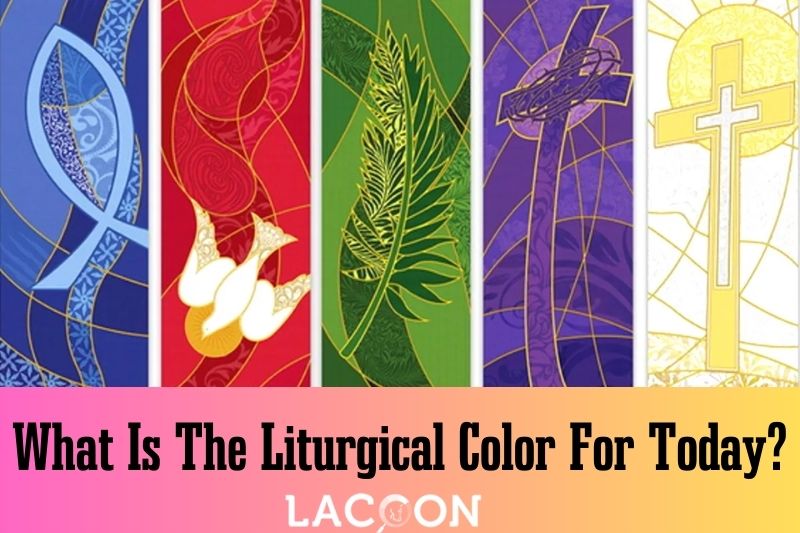Liturgical colors are pivotal in Christian worship, symbolizing the spiritual significance of different liturgical seasons and events.
These colors, which adorn the vestments of clergy and the altars of churches, facilitate a visual connection between the faithful and the mysteries of their faith.
To decipher what is the liturgical color for today, we must delve into the history, as well as comprehend the structure of the Christian calendar.
Lacoon will answer the question and unveil the profound significance behind the use of colors in Christian worship.
The Historical Context of Liturgical Colors

The utilization of liturgical colors in Christian worship can be traced back to the early days of the Church.
At first, there was no standardized system of colors, allowing local churches and clergy to select colors they deemed most fitting for particular seasons or feasts.
However, as Christianity expanded and became more structured, the necessity for uniformity in liturgical practices arose.
By the 12th century, the Roman Catholic Church established a set of liturgical colors that remains largely unchanged.
The Protestant Reformation resulted in variations in liturgical colors among different denominations, but the fundamental principles are consistent across Christianity.
Liturgical Colors, Revised Common Lectionary
| Episcopal | Lutheran (ELCA) | Presbyterian USA | Methodist | United Church of Christ | Roman Catholic | Reformed | Disciples of Christ | Lutheran Missouri | Anglican Canada | |
| Advent Season | Violet or Royal Blue | Blue or Purple | Purple or Blue | Purple or Blue | Purple or Deep Blue | Violet/Purple | Violet/Purple | Violet or Blue | Blue/Purple | Purple/Blue |
| Christmas Eve | White or Gold | White | White | White | White | White | ||||
| Christmas Day | white or Gold | White | White | White or Gold | White | White | White | |||
| Christmas Season | White or Gold | White | White | White | White or Gold | White | White | White | White | White |
| Epiphany | White | White | White | White | White or Gold | White | White | White | ||
| Baptism of the Lord | White | White | White | White | White | |||||
| After Epiphany (Ordinary Time) | Green | Green | Green | Green | Green | Green | White until Second Sunday after Epiphany; then Green | Green | Green | Green |
| Transfiguration | White | White | White | White | White | White | ||||
| Ash Wednesday | Violet or Unbleached Linen | Black | Purple | Black | Purple | Black | Purple | |||
| Lenten Season | Violet or Unbleached Linen | Purple | Red or Purple | Purple | Violet or Beige/Gray | Violet/Purple | Purple | Violet or Blue | Purple | Purple |
| Passion/Palm Sunday | Red | Scarlet or Purple | Red or Purple | Purple | Red | Red | Red or White | Scarlet | Red or Purple | |
| Holy Week | Red | Scarlet or Purple | Purple | Purple | Red | Red or White | Scarlet | Red | ||
| Maundy Thursday | Red | White | Purple | White or Gold | White | None | Scarlet | |||
| Good Friday | Red or Black | None | None or Black, Deep Scarlet | Black, Red or none | Red or Black | None | Black | |||
| Easter Vigil | White or Gold | White | White | White | White | |||||
| Easter | White or Gold | Gold or White | White | White | White or Gold | White | White | White or Gold | White | |
| Easter Season | White or Gold | White | White | White | White or Gold | White | White | White | White | White |
| Pentecost | Red | Red | Red | Red | Bright Red | Red | Red | Red | Red | Red |
| Trinity Sunday | White | White | White | White | White or Gold | White | White | White | ||
| After Pentecost (Ordinary Time) | Green | Green | Green | Green | Green | Green | Green | Green | Green | Green |
| All Saint’s Day | White | White | White | White | White | |||||
| Christ the King | White | White | White | White | White or Gold | White | Gold | White | ||
| Festival Days | White | White | White or Gold | White | White/Red | White and Other | ||||
| Martyr Days | Red | Red | Red | Red |
The Significance of Liturgical Colors

With a clear understanding of the Christian calendar’s structure, we can now explore the liturgical colors associated with each season and their meanings:
Purple: Symbolizing penance, humility, and preparation
White/Gold: Representing purity, joy, and light
Green: Symbolic of hope, growth, and the ongoing journey of faith.
Red: Representing the Holy Spirit, martyrdom, and the blood of Christ.
Blue: The color symbolizes her purity, fidelity, and steadfastness in faith.
Rose: It signifies joy and anticipation amid the penitential seasons.
Black: Historically used for mourning. In recent years, however, it has been largely replaced by purple or red in many churches.
Conclusion
Knowing the liturgical color for a given day requires an extensive understanding of the history as well as the structure of the Christian calendar. By appreciating the profound meaning behind each color, we can forge a deeper connection with the mysteries of our faith and enrich our worship experience.
Moreover, by recognizing the liturgical color for today, we can actively participate in the church’s liturgical life and embrace the spirituality associated with each season and feast.





